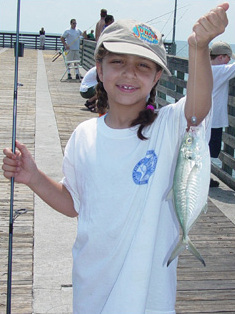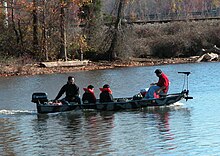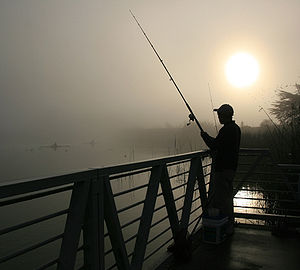Recreational fishing: Difference between revisions
→External links: removed Category:History of sports using Project:AWB |
→Fishing techniques: added image |
||
| Line 44: | Line 44: | ||
==Fishing techniques == |
==Fishing techniques == |
||
{{main|Fishing techniques}} |
{{main|Fishing techniques}} |
||
[[File:Fisherman at Lake Merced.jpg|Fisherman at Lake Merced is using a [[Fishing rod|rod]]|thumb|300px|]] |
|||
Recreational fishing techniques include [[Gathering seafood by hand|hand gathering]], [[spearfishing]], [[Fish net|netting]], [[angling]] and [[Fish trap|trapping]]. |
Recreational fishing techniques include [[Gathering seafood by hand|hand gathering]], [[spearfishing]], [[Fish net|netting]], [[angling]] and [[Fish trap|trapping]]. |
||
Revision as of 00:57, 24 February 2010

Recreational fishing, also called sport fishing, is fishing for pleasure or competition. It can be contrasted with commercial fishing, which is fishing for profit, or subsistence fishing, which is fishing for survival.
The most common form of recreational fishing is done with a rod, reel, line, hooks and any one of a wide range of baits. Other devices, commonly referred to as terminal tackle, are also used to affect or complement the presentation of the bait to the targeted fish. Some examples of terminal tackle include weights, floats, and swivels. Lures are frequently used in place of bait. Some hobbyists make handmade tackle themselves, including plastic lures and artificial flies. The practice of catching or attempting to catch fish with a hook is known as angling. When angling, it is sometimes expected or required that the fish be caught and released.
Big-game fishing is fishing from boats to catch large open-water species such as tuna, sharks and marlin. Noodling and trout tickling are also recreational activities. One method of growing popularity is kayak fishing. Kayak fisherman fish from sea kayaks in an attempt to level the playing field with fish and to further challenge their abilities. Kayaks are stealthy and allow anglers to reach areas not fishable from land or by conventional boat.[1] Sport fishing is dominated by men, although women also participate in the sport.[2]
History
The earliest English essay on recreational fishing was published in 1496, shortly after the invention of the printing press. The authorship of this was attributed to Dame Juliana Berners, the prioress of the Benedictine Sopwell Nunnery. The essay was titled Treatyse of Fysshynge wyth an Angle, and was published in the second Boke of St Albans, a treatise on hawking, hunting and heraldry. These were major interests of the nobility, and the publisher, Wynkyn de Worde, was concerned that the book should be kept from those who were not gentlemen, since their immoderation in angling might "utterly destroye it".[3]
During the 16th century the work was much read, and was reprinted many times. Treatyse includes detailed information on fishing waters, the construction of rods and lines, and the use of natural baits and artificial flies. It also includes modern concerns about conservation and angler etiquette.[4]
-
Sketch of Juliana Berners
-
Izaak Walton
-
Charles F. Holder with his then record 183lb. bluefin tuna catch, 1898.
-
"Angler on a Wintry Lake," painted in 1195 by Ma Yuan, Chinese Song Dynasty, featuring the oldest known depiction of a fishing reel.
Recreational fishing for sport or leisure gained popularity during the 16th and 17th centuries, and coincides with the publication of Izaak Walton's The Compleat Angler, or Contemplative Man's Recreation in 1653. This book is the definitive work that champions the position of the angler who loves fishing for the sake of fishing.[3][5]
More than 300 editions of The Compleat Angler have been published. The pastoral discourse is enriched with country fishing folklore, songs and poems, recipes and anecdotes, moral meditations and quotes from classic literature. The central character, Piscator, champions the art of angling, but also tranquilly relishes the pleasures of friendship, verse and song, good food and drink.[6]
The early evolution of fishing as recreation is not clear. For example, there is anecdotal evidence for fly fishing in Japan as early as the ninth century BCE,[7] and in Europe Claudius Aelianus (175–235 CE) describes fly fishing in his work On the Nature of Animals, as
"a Macedonian way of catching fish... They fasten red (crimson red) wool round a hook, and fix on to the wool two feathers which grow under a cock’s wattles, and which in colour are like wax. Their rod is six feet long, and their line is the same length. Then they throw their snare, and the fish, attracted and maddened by the colour, comes straight at it..."[8]
But for the early Japanese and Macedonians, fly fishing was likely to have been a means of survival, rather than recreation. It is possible that antecedents of recreational fly fishing arrived in England with the Norman conquest of 1066.[8] Although the point in history where fishing could first be said to be recreational is not clear,[9] it is clear that recreational fishing had fully arrived with the publication of The Compleat Angler.
Big-game fishing started as a sport after the invention of the motorized boat. In 1898, Dr. Charles Frederick Holder, a marine biologist and early conservationist, invented this sport and went on to publish many articles and books on the subject noted for their combination of accurate scientific detail with exciting narratives.
Sport fishing

Sport fishing methods vary according to the area fished, the species targeted, the personal strategies of the angler, and the resources available. It ranges from the aristocratic[10] art of fly fishing elaborated in Great Britain,[11] to the high-tech methods used to chase marlin and tuna. Sport fishing is usually done with hook, line, rod and reel rather than with nets or other aids.
The most common salt water game fish are marlin, tuna, tarpon, sailfish, shark, and mackerel.[12]
In North America, freshwater fish include snook, redfish, salmon, trout, bass, pike, catfish, walleye and muskellunge. The smallest fish are called panfish, because they can fit in a normal cooking pan. Examples are crappies, perch, rock bass, bluegill and sunfish.
In the past, sport fishers, even if they did not eat their catch, almost always killed them to bring them to shore to be weighed or for preservation as trophies. In order to protect recreational fisheries[13] sport fishermen now often catch and release, and sometimes tag and release, which involves fitting the fish with identity tags, recording vital statistics, and sending a record to a government agency.
Fishing techniques

Recreational fishing techniques include hand gathering, spearfishing, netting, angling and trapping.
Most recreational fishers use a fishing rod with a fishing line and a hook at the end of the line. The rod may be equipped with a reel so the line can be reeled in, and some form of bait or a lure attached to the hook. Fly fishing is a special form of rod fishing in which the reel is attached to the back end of the rod, and a whipping motion is used to imitate a fly with an artificial fly. Another less common technique is bowfishing using a regular bow or a crossbow. The "arrow" is a modified bolt with barbs at the tip, connected to a fishing line so the fish can be retrieved. Some crossbows are fitted with a reel.
The effective use of fishing techniques often depends on knowledge about the fish and their behaviour including migration, foraging and habitat.[14]
Fishing tackle
Fishing tackle is a general term that refers to the equipment used by fishers. Almost any equipment or gear used for fishing can be called fishing tackle. Some examples are hooks, lines, sinkers, floats, rods, reels, baits, lures, spears, nets, gaffs, traps, waders and tackle boxes.
Tackle that is attached to the end of a fishing line is called terminal tackle. This includes hooks, sinkers, floats, leaders, swivels, split rings and wire, snaps, beads, spoons, blades, spinners and clevises to attach spinner blades to fishing lures.
Fishing tackle can be contrasted with fishing techniques. Fishing tackle refers to the physical equipment that is used when fishing, whereas fishing techniques refers to the ways the tackle is used when fishing.
Rules and regulations
Recreational fishing has conventions, rules, licensing restrictions and laws that limit the way in which fish may be caught. The International Game Fish Association (IGFA) makes and oversees a set of voluntary guidelines. Typically, these prohibit the use of nets and the catching of fish with hooks not in the mouth. Enforceable regulations are put in place by governments to ensure sustainable practice amongst anglers. For example in the Republic of Ireland, the Central Fisheries Board oversees the implementation of all angling regulations, which include controls on angling lures, baits and number of hooks permissible, as well as licensing regimes and other conservation based restrictions.[15]
Fish logs
In addition to capturing fish for food, recreational anglers may also keep a log of fish caught and submit trophy-sized fish to independent record keeping bodies. In the Republic of Ireland, the Irish Specimen Fish Committee verifies and publicizes the capture of trophy fish caught with rod and line by anglers in Ireland, both in freshwater and at sea. The Committee also ratifies Irish record rod caught fish. It also uses a set of 'fair play' regulations to ensure fish are caught in accordance with accepted angling norms.[16]
Competitions
Recreational fishing competitions (tournaments) are a recent innovation in which fishermen compete for prizes based on the total weight of a given species of fish caught within a predetermined time. This sport evolved from local fishing contests into large competitive circuits, especially in North America. Competitors are most often professional fishermen who are supported by commercial endorsements. Other competitions are based purely on length with mandatory catch and release. Either longest fish or total length is documented with a camera and a mandatory sticker or unique item, a practice used since it's hard to weigh a living fish accurately in a boat.
Sport fishing competitions involve individuals if the fishing occurs from land, and usually teams if conducted from boats, as well as specified times and areas for catching fish. A score is awarded for each fish caught. The points awarded depend on the fish's weight and species. Occasionally a score is divided by the strength of the fishing line used, yielding more points to those who use thinner, weaker line. In tag and release competitions, a flat score is awarded per fish species caught, divided by the line strength. Usually sport fishing competitions award a prize to the boat or team with the most points earned.[17]
Industry
The recreational fishing industry consists of enterprises such as the manufacture and retailing of fishing tackle, the design and building of recreational fishing boats, and the provision of fishing boats for charter and guided fishing trips.
"Pay to fish" enterprises provide anglers with controlled access to stocked lakes, ponds or canals. These provide fishing opportunities outside of the permitted seasons and quotas applied to public waters. In the United Kingdom, commercial fisheries of this sort charge access fees. In North America, establishments usually charge for the fish caught, by length or by weight, rather than for access to the site although some establishments charge both types of fees.
Recreational fishing is a multi-billion dollar industry[18] In the USA, about 12 million recreational saltwater fishers generate $30 billion in economic impact and support 350,000 jobs.[19]
See also
Notes
- ^ Null, Scott and Mcbride, Joel (2007) Kayak Fishing: The Ultimate Guide.Heliconia Press. ISBN 978-1896980287
- ^ Broughton, Bruno (2001) Women And Angling
- ^ a b Cowx, I G (2002) Handbook of Fish Biology and Fisheries, Chapter 17: Recreational fishing. Blackwell Publishing. ISBN 063206482X
- ^ Berners, Dame Juliana. (2008). In Encyclopædia Britannica. Retrieved June 20, 2008, from Encyclopædia Britannica Online
- ^ The Treatyse, Izaak Walton, and English Angling Literature Clarke Historical Library. Retrieved 3 February 2009.
- ^ Walton, Izaak. (2008). In Encyclopædia Britannica. Retrieved June 20, 2008, from Encyclopædia Britannica Online
- ^ Herd, Andrew (2003) The Fly. Medlar Press. ISBN 9781899600298
- ^ a b McCully, CB (2000) The Language of Fly-Fishing Taylor & Francis, pp. 76_78. ISBN 9781579582753.
- ^ Schullery, Paul Fly fishing History: Beginnings: Aelian Lives
- ^ Horrox R and Ormrod WM (2006) A social history of England, 1200-1500 Cambridge University Press, pp 278–9. ISBN 9780521783453.
- ^ A fly fishing history
- ^ Dunn, Bob (2000) Saltwater Game Fishes of the World. Australian Fishing Network.ISBN 978-1865130101
- ^ Catch And Release Fishing
- ^ Keegan, William F (1986) The Optimal Foraging Analysis of Horticultural Production American Anthropologist, New Series, Vol. 88, No. 1., pp. 92-107.
- ^ Fishing in Ireland Central Fisheries Board Website
- ^ ISFC Trophy Fish Website Irish Specimen Fish Committee
- ^ Sportfishing in America - American Sportfishing Association
- ^ Angling Retains its Mainstream Appeal and Broad Economic Impact-American Sportfishing Association
- ^ NOAA Fisheries: Recreational Fishing Services.
References
- Baron, Frank P (2003) What Fish Don't Want You to Know: An Insider's Guide to Freshwater Fishing. International Marine/Ragged Mountain Press. ISBN 978-0071417143
- Cookea, Steven J and Cowx, Ian G (2006) Contrasting recreational and commercial fishing Biological Conservation, vol 128, issue 1, p. 93-108.
- Mason, Paul (2007) Fishing (Recreational Sports). Macmillan Education Australia Pty Ltd . ISBN 978-1420205831
- Pitcher, Tony J and Hollingworth, Chuck (editors) (2002)Recreation Fisheries: Ecological, Economic, and Social Evaluations. Wiley-Blackwell. ISBN 978-0632063918
- Schultz, Ken (2004) Ken Schultz's Field Guide to Saltwater Fish John Wiley and Sons. ISBN 9780471449959
External links
- University of Washington Freshwater and Marine Image Bank Images of Sport Fishing
- Recreational Fishing Laws
- Fishing advice on how to fish & where to fish
- Sport Fishing Photos
- Template:Dmoz
- Fishing Forum
- SeaWeb (2004) Study In Science Reveals Recreational Fishing Takes Big Bite Of Ocean Catch. ScienceDaily. Retrieved 30 April 2008.
- EC rewrites rules on recreational fishing





